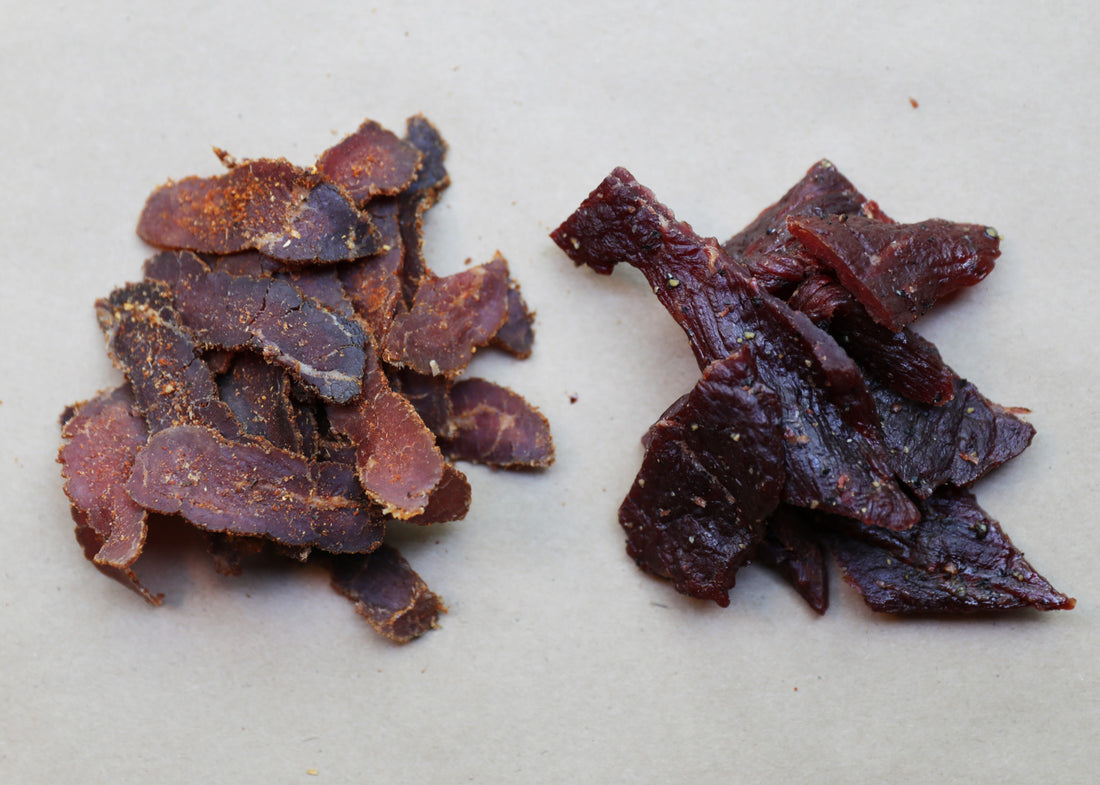
What is the difference between Biltong and Beef Jerky?
Share
The difference between beef jerky and Biltong is quite complicated. We wrote this blog to illustrate a few of the differences while also highlighting some similarities. Biltong and Beef Jerky are both made with beef, but the differences are evident in the way they look, their texture, and most importantly, the taste.
Difference in how Biltong & Beef Jerky is dried:
Typically jerky is made by slicing beef into thin squares or rectangles that are dehydrated at a low temperature (120-160 °F) and “cooked” for about six hours. (The word jerky is derived from the Quechua word charqui which translates to "burnt meat," true story). This process results in a dry, sometimes leathery, piece of beef with little natural flavor. To counter this, jerky brands sometimes soak their beef in a sugar marinade, which allows the beef to appear more tender (because sugar retains moisture). Other jerky brands will load up on flavors like Teriyaki or Barbecue. We know that not everyone's taste preferences are the same and that some people prefer the texture and taste of jerky, but if you are looking for a more natural and tender snack, then Biltong is for you.
Biltong is made by cutting large slabs of beef (about 5 times the size of regular jerky) and marinating the slabs in vinegar and salt. The slabs of beef are then spiced with only a few natural ingredients, most important being coriander, and hung to dry in an air-controlled room for up to fourteen days. The slabs are then sliced and packaged and boom, you have Biltong. The air-drying process leaves the meat naturally tender so there is no need to add any sugar and thus, Ayoba Biltong is sugar free. The drying process also allows for the beef to have some fat without becoming rancid, which is a big problem when making jerky and is another reason for slicing jerky so thin.

The different ingredients used in Jerky and Biltong:
Jerky can be spiced and flavored using almost anything. Flavors range from Barbeque and Teriyaki to Pho and even caffeinated Jerky. This can lead to a long and dubious ingredient list. Don't get us wrong, there are definitely a few jerky companies out there doing a good job by avoiding artificial ingredients, but the taste and texture still cannot compare to Biltong. "Chemical preservatives, such as sodium nitrite, are often used in conjunction with the historical salted drying procedure to prepare jerky."- Wikipedia
Our Biltong is made with the same methods our ancestors have used for over 400 years. This means we do not use any artificial preservatives or chemicals (or nitrates), but rather clean and natural spices such as Coriander, Sea Salt, Pepper, and our special blend of Worcestershire Powder. For our Spicy version we wanted to capture the flavor of Cayenne and Chilli Powder rather than killing your taste buds with Habanero or Jalapeño. Some Biltong recipes call for brown sugar but we have found that this ads no real value to the flavor profile.
Ayoba Biltong is also the only Biltong in the USA that is Paleo Certified, Keto Certified AND Whole30 Approved!

Similarities between Biltong & Jerky:
Now that we have identified the main differences between Biltong & Jerky, let's focus on some of the similarities. For one, both can be made with meat other than beef. It is not uncommon to find Jerky and Biltong made with deer meat (venison), ostrich, wild boar, or even something more exotic like Kudu or Eland. Both were used by pioneers and Voortrekkers as they left their colonies in search of expansion. Dried meats are great for travel because of how long it lasts and the protein it provides during treacherous travels. Biltong and Jerky are both great diet snacks (although Biltong boasts a cleaner ingredient list), and lastly they both pair great with your favorite local beer.
